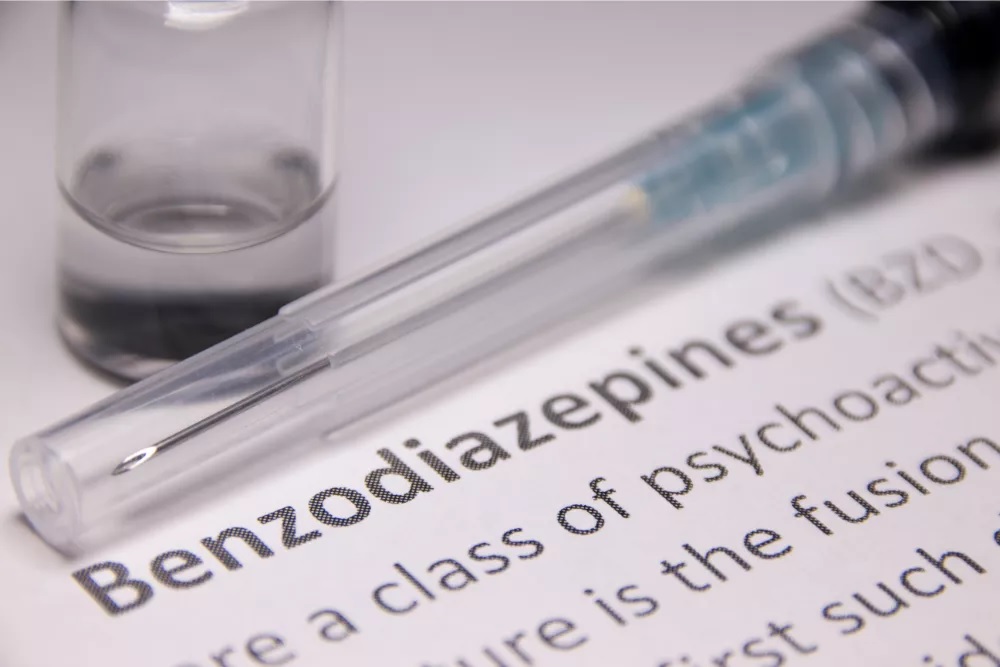Benzos stay in your system and can be detected in certain body parts for up to 90 days.
Avenues Recovery, experts in addiction treatment, explore how long benzos last in urine, blood, hair, and saliva, which factors affect how long benzos stay in your system and benzo’s half-life.
What Are Benzos?
Benzos, short for benzodiazepines, are a class of psychoactive drugs that are commonly prescribed to treat various medical conditions, mainly those related to anxiety, insomnia, and seizures. They are known for their calming and sedative effects on the central nervous system. Benzodiazepines work by enhancing the activity of a neurotransmitter called gamma-aminobutyric acid (GABA), which inhibits the firing of neurons, leading to reduced anxiety and relaxation.
Benzodiazepines come in various forms and have different durations of action. Some examples of well-known benzodiazepines include Alprazolam (Xanax), Lorazepam (Ativan), Diazepam (Valium), Clonazepam (Klonopin), Temazepam (Restoril), and Chlordiazepoxide (Librium).
Benzodiazepines are generally considered safe and effective when used as prescribed and for short periods. However, there are numerous risks and side effects associated with its use.
Why Test for Benzos?
Many people worry about how long benzos stay in the system for a drug test.
Many companies require their employees to do drug testing before starting a new job. Drug testing is also commonly done for child custody and parole cases. In addition, most professional athletic teams require regular drug testing to ensure their athletes are in top form and drug-free.
Most drug tests test for metabolites, molecules left in the body once the body has processed the drug. These molecules can stay in the system much longer than the drug itself.
How Long Do Benzos Stay In the System for a Drug Test?
There are multiple methods to detect drug traces in the body, as they circulate through different systems during metabolism. Organizations use various testing techniques to analyze these substances in specific areas.
How Long Do Benzos Last in Urine?
Benzos can last in urine for several weeks, depending on the type.
- Short-acting benzos, like Halcion, can last in the urine for 24 hours.
- Intermediate-acting benzos such as Xanax, Klonopin, Restoril, and Ativan can last in the urine for 1- 5 days after use.
- Longer-acting benzos like Valium may show up on a urine drug screen 5 - 8 days after use.
- Those who misuse benzos chronically have detected benzos in their urine up to 30 days after the last use.
Urine testing is the most common type of testing, and can be accurate for several weeks.
How Long Do Benzos Stay in Your Blood?
Benzos stay and may be detected in the blood from one hour to eight days. Blood testing can be invasive and expensive. It is quite accurate yet used less commonly. Results are usually available immediately.
How Long Do Benzos Stay in the Hair?
Benzos can be detected in hair follicles for up to 90 days. Hair testing is used less often than other tests because most tests only test for current drug use.
How Long Does Benzodiazepine Stay in the Saliva?
Benzos can stay in the saliva for up to two days. Saliva tests are less invasive than urine tests.

Which Factors Affect How Long Benzodiazepine Stays in Your System?
Benzos may stay in some peoples’ bodies longer than others based on several factors:
- Type of Benzos - some benzos take longer than others to clear out of the system. Long-acting benzos take the longest to clear out completely.
- Age - the older the user is, the longer it takes for benzos to be cleared from the body.
- Weight - the heavier the user is, the longer it takes for benzos to exit the body.
- Kidney function - it takes longer for benzos to be cleared from the system from users with poor kidney function, especially if they were taking Chlordiazepoxide and Lorazepam.
- Liver function - it takes benzos longer to exit the system for users with poor liver function, especially if they were taking Chlordiazepoxide and Diazepam.
- Dosage - the higher the dosage, the longer it takes to leave the system.
- Metabolism - the slower the metabolism, the longer it takes to leave the system.
- Frequency of use - the longer a user has been using benzos, the longer it will take to clear from the system. For a one-time user, it will clear out immediately.
- Polysubstance Use - ingesting other drugs (or alcohol) with benzos can cause the benzos to stay in the system for longer
- Fluid Intake - the more fluids a person drinks, the quicker the benzos will be flushed from the system.
- History of Drug Use
- Medical History
- Manner of Ingestion
- Individual’s Physical Health
- Gender
Benzo Half-Life
To determine how long it will take for benzos to be cleared from the system, it is crucial to understand the half life of benzos. The peak level is when a drug is at its highest concentration in the bloodstream. The benzo half-life describes how long it takes to get rid of half of a dose. Most drugs take five half-lives to be cleared from the body.
Peak levels and benzodiazepine half-life depend on benzos type, dosage, and how it was ingested.
Here is a benzos half-life chart for benzos taken orally:
| Benzodiazepine | Time to peak level | Half-life |
| Alprazolam | 1 - 2 hours | 12 - 15 hours |
| Chlordiazepoxide | Several hours | 24 - 48 hours |
| Oxazepam | 3 hours | 5 - 11 hours |
| Lorazepam | 1 - 2 hours | 10 - 20 hours |
| Diazepam | 0.5 - 6 hours | 20 - 80 hours |
| Clonazepam | 1 - 4 hours | 18 - 50 hours |
Possible Short-Term Effects of Benzos
The following are common short-term effects of benzodiazepines:
- Anxiety reduction
- Stress reduction
- Euphoria
- Calm
- Depression
- Confusion
- Slurred speech or stuttering
- Nausea and loss of appetite
- Impaired thinking and memory loss
- Drowsiness
Possible Long-Term Effects of Benzos
The following are common long-term effects of benzodiazepines:
- Anxiety
- Depression
- Memory loss
- Paranoia and aggression
- Addiction
- Nausea
- Skin rashes
- Weight gain
- Personality change
- Weakness and lethargy
Withdrawal from Benzodiazepine
Benzodiazepine withdrawal can be both physically and psychologically intense. As the body adjusts to the absence of the drug, individuals may experience symptoms like anxiety, insomnia, tremors, and in some cases, seizures. It’s essential to seek professional help when undergoing withdrawal to minimize risks and ensure a safe process. Gradual tapering under medical supervision is often the best approach to managing withdrawal symptoms.
How to Get Benzos Out of Your System
Getting benzodiazepines out of your system involves more than just detox; it requires a structured treatment plan that addresses both the physical and psychological aspects of addiction. The process typically starts with medically supervised detox, where the body eliminates the drug under professional care. After detox, individuals move into rehab, which includes therapy and counseling to address the root causes of addiction, develop coping strategies, and prevent relapse.
Recovery is a long-term process, and each stage of treatment plays an essential role in achieving lasting sobriety. With the right support and commitment, you can break free from benzodiazepine addiction and rebuild your life.
If you or a loved one is ready to begin the recovery journey, Avenues Recovery is here to guide you through each stage of treatment. Our comprehensive programs are tailored to meet your unique needs, ensuring a safe and effective path to long-term healing. Contact Avenues Recovery today to learn more about our services and how we can support you every step of the way.



